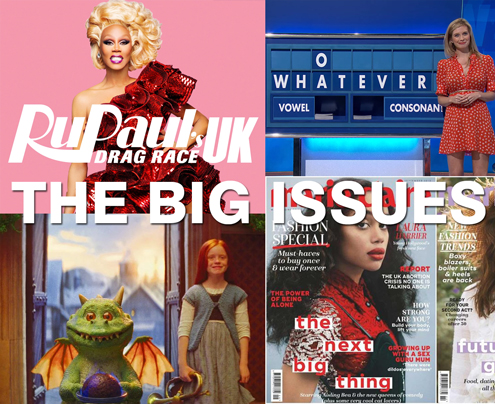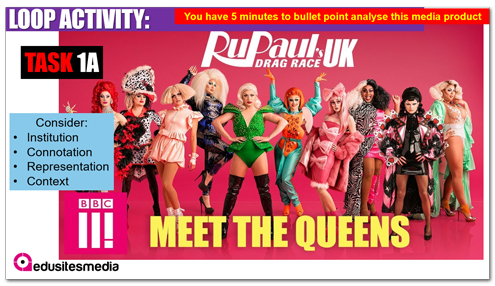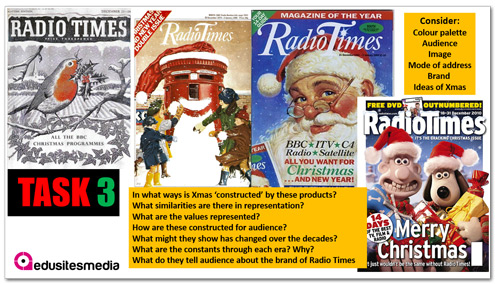
Illuminate your A Level Media study programme with these 4 fresh lessons inspired by current events...
One of the draw backs with the new examinations with their QCA approved ‘canon’ of media products deemed worthy of study, is that they may all too easily become the only products presented to our students for study, a nervous fixation or life-belt for anxious teachers concerned to cover all of the territory of the new specifications in as much depth as possible.
Hopefully, now that we have had the first full assessments we are clearer in how these study products ‘work’ and we can now trust that the exam board exhortations, to see these products simply as a common core of material for students to hang theoretical models and their understanding upon, is true.
Such products have never been portrayed as exclusive, in fact, having worked on preparing over 600 lessons for Edusites that cover the entire two-year course for all three boards, I know that each board has striven to communicate this. More than this, each of the three A Level boards constantly exhorts staff to widen the range of study, to use the set products as a jumping off point for wider exploration of print, broadcast and digital forms.
So, the time seems right for this series of blogs with accompanying lessons inspired by current events that, in their turn, illuminate the study of the set products for each board. In this way we can ensure that our teaching content is constantly refreshed and kept current and relatable.
These lessons are aimed at practitioners of all three boards so do not rely on any of the formal set products. In fact, in some cases they may apply to print, broadcast and digital alike. I leave it to you, should you use the base material of each lesson, to add reference to the relevant set products.
The first of what I have called ‘The Big Issue Lessons’ is focused on print for A Level study, and as such, may be used in Term 1 with Year 12 or Term 4 of Year 13.
Barry Rainsford, Author and Teacher of Media, Film and English
Big Issues Lesson 1: Thinking Print

Click here for 'Thinking Print' Lesson Slides*
In the first week of term news broke that the print edition of Marie Claire magazine was to cease. This inspired obvious thoughts of how this is indicative of changes in media institutions that dominate the print market.
A long line of previous closures/move to digital of similar products over the past 12 months creates good learning opportunities to investigate the shifts in audience needs/demands for the print product, especially the women’s lifestyle magazines that are now following the earlier seismic culling of titles in the male lifestyle magazine market. In short, this is a good chance to introduce/review how Hesmondhalgh, Curran and Seaton and Shirky might be applied to real world media industry changes.
This 'thinking' lesson features an initial survey of mainstream 2019 women’s lifestyle print magazines – their nature and sales – with some think/pair/share tasks.
It then explores a simple case study of Marie Claire and the manner in which it had evolved to become a product very aware of millennial sensitivities, preaching ideas of body positivity and diverse ideas of beauty.
The second part of the lesson resource invites students to apply their acquired knowledge to contemporary products via comparisons with their set products and offers a range of suitable exam style tasks based around this.
Big Issues Lesson 2: Thinking Identity

Click here for 'Thinking Identity' Lesson Slides*
For me, the teaching of institution/industry has often been the most challenging in overcoming the initial reaction of students seeing it as the ‘dry’ part of the specification. As such, the is always finding a way to teach the subject that excites students whilst also enabling them to understand the institutional source as key to a products' shape and how it arrives at its audience.
Sadly, the trope of the BBC with its remit of (all together now) ‘educate; inform; entertain’ has too great a dominance in textbook teaching and student exam responses.
So, how do we get away from this? How do we enable our students to be in a position to be able to offer something relatable to the task that is different, that stands out from the pack of answers? For me, ever since the light bulb moment in my first summer series as A Level Media Examiner in the mid-1990s, it has always been to see institution as the starting point of product study rather than the bolt on afterthought.
Every mass media product has an intended audience. If not, it won’t get made. The audience is defined by the institution.
In this sense, RuPauls Drag Race UK as BBC content makes sense. If we add in the panel of judges – Graham Norton and Alan Carr – and the celebrity judges Maisie Williams, Geri Horner, Jade Thirlwall, Andrew Garfield, Michaela Coel, Cheryl, Twiggy, Lorraine Kelly and Stacey Dooley – we infer that these are the new wave of celebrity: a mix of BBC1 mainstream fixtures (Horner, Garfield, Cheryl, Twiggy, Kelly) and 2019 aspirers and influencers (Williams, Thirlwall, Coel, Dooley)
The material can thus be used to discuss identity and how it is constructed/shaped by modern broadcast media but also as a means of engaging the students in discussion of the brand image of modern media institutions and their constant need to construct a relatable dialogue with their audience in the name of retention as well as acquisition.
The Lesson Slide resource Big Issues 2: Broadcasting Identity features an initial pop quiz of celebrity/star/icon and some ideas about influencers with think/pair/share tasks, before exploring a simple case study of RuPaul and the manner in which it has evolved awareness of millennial sensitivities and diverse ideas of identity.
The second part of the lesson resource invites students to apply their acquired knowledge to other contemporary products as well as making comparisons/connections with their set products to offer a range of suitable exam style tasks.
Big Issues Lesson 3: Thinking Branding

Click here for 'Thinking Branding' Lesson Slides*
I Want To Be Elected
Who’d have thunk it? A pre-Xmas election. After the initial moans of ‘how could they?’ and ‘they’ve ruined Christmas’ a more sobering thought occurs that this is, in fact – as far as TV is concerned - the ideal time for UK elections to be held.
Looking at the schedules of UK terrestrial TV platforms such as BBC, ITV, C4 it’s actually a very good fit. The 2019 winter schedules suggest that we have an insatiable demand and craving for shows dominated by reality competitions that, like our election, focus on faded celebrities or ‘look at me’ wannabes competing for our attention and votes. A quick glance at my programme guide for this week in November offers:
X-Factor; The Apprentice; Strictly Come Dancing; I’m a Celebrity; MasterChef: The Professionals; RuPaul’s Drag Race UK to name but a few.
What Big Brother and Pop Idol began in the dark days of the century, every TV platform now pursues. Apart from an obvious discussion on the implications of this obsession for UK society in 2019, they do offer an ideal means to the astute Media Teacher of prodding students into consideration of the nature of contemporary TV institutions and their branding – if they offer so much that is ‘the same’ then how do they set about persuading us that they are the platform of choice?
For me, the teaching of institution/industry is often the most challenging in overcoming the initial reaction of students seeing it as the ‘dry’ part of the specification. The challenge is finding a way in that excites them whilst also enabing them to make sense of and apply complex theoretical models underlying institutional influence and structures.
So, how do we do this, how do we enable our students to be in a position to offer ideas relatable to the exam task that are different, that stand out from the pack of answers? For me, it is seeing institution as the starting point of any product study rather than the bolt on afterthought it too often is in the textbooks. More than this, in seeing institutional source/platform being as key as the writer, director and any other of the creative elements in shaping the final structure of the product and discussing it as such, relating each element back to institutional origins – EG: how can we understand any newspaper article without some awareness of ownership and its effect on the news agenda or the readerships confirmation bias or cognitive dissonance?
Start with the very basic fact: Every mass media product has an intended audience. If not, it won’t get made.
Secondly, if it fails to relate to that audience it won’t survive into Season 2 or into secondary markets. The TV product audience is defined by the institutional platform.
We have some very important calls to make here. the divide between PSB and commercial is one we have to consider of significance. The commercial nature of most TV platforms means that broad appeal and simple popular cultural products offer the best chance of maximising audience and profitability. As such, this will also most often determine the commissioning of products that are ‘safe’, usually repetitions of the dominant genre cycle. This is of course the territory of Hesmondhalgh and Curran and Seaton. PSB, with no urge to make profit commissions products that are more challenging and of a more limited or niche appeal. They can literally ‘afford’ to take risk because their objectives are different to the commercial platforms.
I find C4 always offers the chance to discuss a very specific remit, having a foot in both the PSB and commercial sectors that is then layered with the remit to be challenging and diverse in its programming and audience appeal. The lesson resource uses C4 as its starting point.
This Big Issue 3 Mini Lesson on branding identity features material offering a variety of learning experiences that can be tailored to explore the wider ideas of platforms and brands. Select those most appropriate to your group or set some tasks for Home Learning or Revision for exams.
Derry Girls offers an effective task of interpreting the connotations of the campaign poster in defining the nature of the programme and the audience it seeks. This leads into wider consideration of products and their platform brand. Tasks 5 and 6 where students are asked to consider the use of the C4 campaign responding to the trolling of the channel’s stars is typical of the brand – challenging audiences and embracing the opportunity of highlighting the diversity of its line-up.
Task 7 is more academic in nature, a chance to consider the role of PSB and theoretical models (very much aimed at Year 13) that leads gently into Task 8 and Task 9 where they are asked to apply the ideas to their own set products.
The resource completes with an exemplar exam task after a task that asks them to archive their learning in a Wikipedia style task.
Discussion of the brand image of modern media institutions leads to consideration of their unrelenting need to construct a relatable dialogue with their audience in the name of retention, audience refreshment and acquisition.
The resource is styled as Pick n’ Mix – it invites students to apply their acquired knowledge to other contemporary products as well as making comparisons/connections with their set products to offer a range of suitable exam style tasks.
Big Issues Lesson 4: Brand Values...Xmas adverts

Click here for 'Thinking Brand Values' Lesson Slides*
I recently read an interview with Noddy Holder about his career and the music he and Jim Lea (his co-writer) created. Having booked Slade many times in the early 1970s when they were a relatively unknown ‘good time live band’ featuring on underground radio, I found it of particular interest when, talking of the commercialisation of their career and in particular Merry Xmas, Noddy noted ‘It’s my pension’. With the song generating over £500,000 in royalties every year since its 1973 release it’s not hard to see why.
Reference books tell us that the ‘Merry Xmas’ Slade marketing campaign started the Christmas Number 1 obsession by beating I Wish It Could Be Xmas Everyday into the number 2 slot on Christmas Day 1973; an obsession that still holds sway even in today’s digital streaming culture.
For my two boys growing up in the 1990s, Christmas began with the sighting of the first Coca-Cola Christmas TV advert with its ‘Holidays are coming’ mantra – this year it was first spotted during Monday Night Football on Sky on the 25th November. So, it’s easy to see why, for me, teaching A Level media demands a week focused on analysing how Christmas campaigns can help us understand the manner by which mass media products use shared values and understandings to construct audiences.
Clearly, successful campaigns such as those promoting retailers, focus on a brand message established over years. These create a bond between the brand and the consumer that the spirit of the Christmas season can emphasise – family; friendship; sharing. For retailers like John Lewis, Marks and Spencer’s, Tesco, Asda etc their product range and merchandise means that their audience is large and diverse: we all need to eat, drink, wash, clean etc. Their aim is not that of selling one product, such as the exam board Set Products where we look at a computer game, a fragrance, a film marketing campaign or TV show in isolation. Retailers are selling a brand that encompasses tens of thousands of product lines, so their emphasis is on themselves, persuading the audience that theirs is a brand on their side – reliable; value for money; supportive; trusted.
In the slide resource one of the initial tasks asks students to identify retailers brand slogans – Every little Helps; Never knowingly undersold etc. – and to discuss the connotations for consumer perceptions. It would help for them to also band the retailers according to their target market socio-economic class (i.e. Waitrose clearly via price and product lines targets a very different socio-economic group to Lidl) From this point we can then begin to better understand the nature of the Christmas campaigns, how despite this disparity they have been forced to adapt brand intentions to follow in the wake of the John Lewis template for Christmas campaigns.
This is all about audience expectations driven by the social media conversations that have sprung up around such adverts to the extent that the adverts themselves have become products in their own right (Hesmondhalgh), as much a part of the popular culture as the Christmas Number 1 or the Coca-Cola Christmas campaigns that originally constructed our current icon of Santa Claus with his red coat and beard (Curran and Seaton).
The Christmas adverts fall very much into the modern advertising idea that brands have a narrative, that they are perceived by audience consumers more in terms of how we feel about a brand as much as what we know of a brand or how we might use it. It’s why brands are protective of their media image, dropping celebrity ambassadors or endorsements at the first whiff of controversy or behaviour that is damaging to the brand.
The lesson slides for Big Issue 4: Brand Values feature material that offers a variety of learning experiences that can be tailored to explore the wider ideas of brands and values. Select those most appropriate to your group or set some tasks for Home Learning or Revision for exams.
The notion of Santa as a media construct by Coca-Cola is always a good example of the idea of shared values and popular culture, whilst the Sainsbury’s WW1 chocolate campaign from Christmas 2014 is useful for Year 13 to exercise their theoretical and ethical ideas.
This resource is styled as a ‘Pick n’ Mix’ – it invites students to apply their acquired knowledge to other contemporary products as well as making comparisons/connections with their set products to offer a range of suitable exam style tasks.
*All slides are accessible to view with a live wifi connection using Safari, Firefox or Internet Explorer